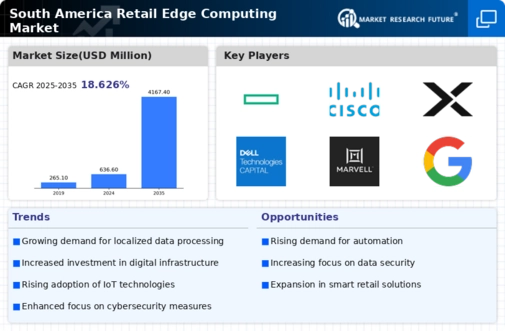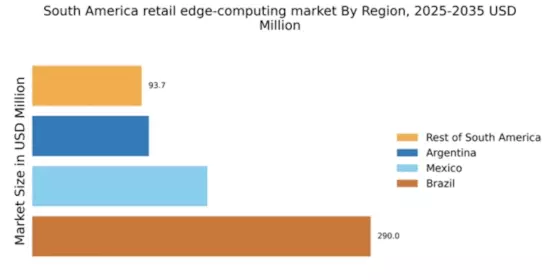Increased Focus on Data Security
In the context of the retail edge-computing market in South America, there is an escalating emphasis on data security. As retailers adopt more sophisticated technologies, the risk of data breaches and cyber threats becomes a pressing concern. Edge computing offers enhanced security features by processing data closer to the source, thereby minimizing the risk of exposure during transmission. Retailers are increasingly investing in edge-computing solutions that incorporate advanced security protocols to protect sensitive customer information. It is estimated that the cybersecurity market in South America will reach $30 billion by 2025, indicating a strong correlation between the growth of edge computing and the need for robust security measures in retail operations.
Expansion of E-commerce Platforms
The retail edge-computing market in South America is significantly influenced by the rapid expansion of e-commerce platforms. As online shopping continues to gain traction, retailers are compelled to enhance their digital infrastructure to support seamless transactions and customer experiences. Edge computing plays a crucial role in optimizing the performance of e-commerce applications by reducing latency and improving load times. Recent data indicates that e-commerce sales in South America are expected to surpass $100 billion by 2025, necessitating robust edge-computing solutions to handle the increasing volume of online transactions. This growth in e-commerce is likely to drive investments in edge-computing technologies, enabling retailers to better serve their customers and remain competitive.
Rising Demand for Real-Time Data Processing
The retail edge-computing market in South America is experiencing a notable surge in demand for real-time data processing capabilities. Retailers are increasingly recognizing the necessity of immediate data analysis to enhance operational efficiency and customer engagement. This trend is driven by the growing reliance on data analytics to inform inventory management and sales strategies. According to recent estimates, the market for edge computing in retail is projected to reach approximately $1.5 billion by 2026 in South America, reflecting a compound annual growth rate (CAGR) of around 25%. This demand for real-time insights is compelling retailers to adopt edge-computing solutions that facilitate faster decision-making and improved responsiveness to market changes.
Adoption of AI and Machine Learning Technologies
The integration of artificial intelligence (AI) and machine learning technologies is emerging as a pivotal driver in the retail edge-computing market in South America. Retailers are leveraging these technologies to analyze customer behavior, optimize inventory, and personalize marketing strategies. Edge computing facilitates the deployment of AI algorithms at the data source, enabling real-time analytics and decision-making. This trend is expected to enhance operational efficiency and customer satisfaction. Recent projections suggest that the AI market in retail could reach $10 billion in South America by 2026, underscoring the potential for edge-computing solutions to support AI-driven initiatives and transform retail operations.
Government Initiatives Supporting Digital Transformation
Government initiatives aimed at promoting digital transformation are playing a crucial role in shaping the retail edge-computing market in South America. Various countries in the region are implementing policies to encourage technological innovation and infrastructure development. These initiatives often include funding for digital projects and incentives for businesses to adopt advanced technologies. As a result, retailers are increasingly investing in edge-computing solutions to align with government objectives and enhance their competitive edge. The South American government is expected to allocate over $5 billion towards digital infrastructure projects by 2025, which could significantly bolster the adoption of edge-computing technologies in the retail sector.


















Leave a Comment